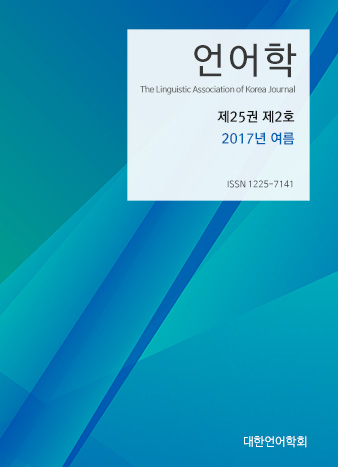대한언어학회 전자저널
25권 2호 (2017년 6월)
- Clausal architecture of auxiliary verb and periphrastic causative constructions in Korean
-
최영식
Pages : 23-41
Abstract
Choi, YoungSik. (2017). Clausal architecture of auxiliary verb and periphrastic causative constructions in Korean.The Linguistic Association of Korea Journal, 25(2), 23-41. I show that auxiliary verb construction in Korean is mono-clausal, using negation, manner adverbial and argument projection, prosodic boundary of pause as valid tests. The present result is quite in agreement with the cross-linguistic observation in the literature (Anderson 2006), according to which the auxiliary verb construction is mono-clausal. I will also show that when the same sentence is construed as a non-auxiliary verb construction, it is a complex sentence with a non-complement subordinate clause. I will also argue that periphrastic causative construction is a non-auxiliary verb construction, too, a complex sentence with a complement clause. The present research will have a non-trivial implication on a better understanding of the auxiliary verb constructions in Korean in general.
Keywords
# auxiliary # complement # periphrastic # complex
References
- Aikhenvald, A. (2006). Serial verb constructions in typological perspective. In A. Aikhenvald & R. M. W. Dixon (Eds.), Serial verb constructions (pp. 1-68). New York: Oxford University Press.
- Anderson, G. (2006). Auxiliary verb constructions. New York: Oxford University Press.
- Bratt, O. (1996). Argument composition and the lexicon: Lexical and periphrastic causatives in Korean. Doctoral dissertation, Stanford University, Stanford, CA.
- Borer, H. (1983). Parametric syntax. Dordrecht: Foris.
- Chai, M.-H. (1999). Is the causative verb an auxiliary? In Proceedings of Harvard Studies in Korean Linguistics, 8, 235-251.
- Choi, H.-P. (1935). Our grammar. Seoul: Cengumsa.
- Choi, Y. (2004). Reexamination of syntactic approaches to Korean V-e V compounds. In Proceedings of Harvard Studies in Korean Linguistics, 9, 386-399.
- Choi, Y. S. (2013). Verb raising in Korean redux. The Linguistic Association of Korea Journal, 21, 31-53.
- Choi, Y. S. (2014). Null argument redux. The Journal of Studies in Language, 29, 865-886.
- Choi, Y. S. (2016). V-e V in Korean is not verbal serialization. Studies in Modern Grammar, 91, 81-102.
- Chomsky, N. (1981). Lectures on government and binding. Dordrecht: Foris.
- Chomsky, N. (1986). Knowledge of language: Its nature, origin, and use. New York: Praeger.
- Chomsky, N. (1995). The minimalist program. Cambridge, MA: MIT Press.
- Chomsky, N., & Lasnik, H. (1977). Filters and control. Linguistic Inquiry, 8, 425-504.
- Chung, T. (1993). Argument Structure and Serial Verbs in Korean. Doctoral dissertation, The University of Texas, Austin.
- Dixon, R. M. W. (2006). Complement clauses and complementation strategies in typological perspective. In R. M. W. Dixon & A. Aikhenvald (Eds.), Complementation: A crosslinguistic typology (pp. 1-48). Oxford: Oxford University Press.
- Jaeggli, O. (1982). Topics in romance syntax. Dordrecht: Foris.
- Kang, M.-Y. (1988). Topics in Korean syntax: Phrase structure, variable binding and movement. Doctoral dissertation, MIT, Cambridge, MA.
- Kim, B.-K. (1993). The structure and the argument linking convention of V-V compounds in Korean. In Proceedings of Harvard Studies in Korean Linguistics, 5, 80-192.
- Kim, Y. (1992). Three types of key ha causative verb construction. Kwukehak (Korean linguistics), 54, 89-120.
- Lee, H.-B. (1976). Notes on pronouns, reflexives, and pronominalization. Ehak Yunkwu (Linguistic Research), 12, 253-263
- Lee, J.-H. (1993). Postverbal adverbs and verb movement in Korean. In Proceedings of Japanese/Korean Linguistics, 2, 429-446.
- Lee, S. (1993). The syntax of serialization in Korean. In Proceedings of Japanese/Korean Linguistics, 2, 447-463.
- Nam, K.-S., & Ko, Y.-G. (1993). Standard Korean grammar. Seoul: Tower Publishing.
- Perlmutter, D. (1971). Deep and surface constraints in syntax. New York: Holt, Reinhart and Winston.
- Sohn, H.-M. (1994). Korean. New York and London: Routledge.
- Sohn, H.-M. (1999). Korean. Cambridge: Cambridge University Press.
- Stewart, O. T. (2001). The serial verb construction parameter. New York and London: Garland Publishing.
- Suh, C.-S. (1992). Study of Korean grammar II. Seoul: Hankwuk Publishing.
- Suh, C.-S. (2013). A Korean grammar. Seoul: Jipmwun Publishing.
- Um, H.-J. (2017). The syntactic structures of long form causative constructions in Korean. Studies in Modern Grammar, 92, 107-122.
- Yang, D.-W. (1976). Korean negation revisited. Ene (Language), 1, 183-217.
